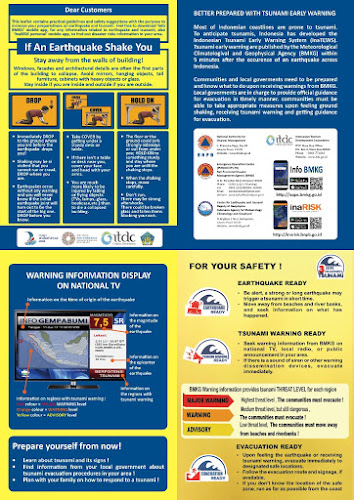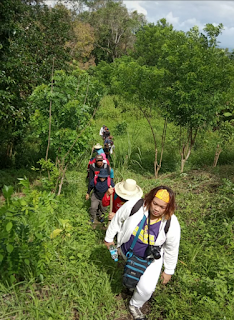Responding to Tsunami Sunda Strait: Volunteering Service of DRT MENWA UI
Background
When I heard about the news on the tsunami that hit the Sunda Strait, I was completing my final assignment with UNESCO for the Haze Project in Riau under the Malaysia funds in Trust (MFIT) with the Social and Human Sciences (SHS) Unit. Honestly, I could not get rid the thought out of my head to take part in the response, the main reason is that one of the affected areas, Pandeglang, was one of my project site in 2014-2016 when I was working for the Project in Building Model for Tsunami Preparedness: Capacity Building for Schools and Communities under the support of Indonesia Funds in Trust (IFIT) with Disaster Risk Reduction and Tsunami Information Unit (DRRTIU) of UNESCO Office Jakarta in partnership with LIPI and BMKG, see https://www.youtube.com/watch?v=l-X5lfWkb_U. I finally responded to the situation on 28 December to 30 December 2018, 5 days after the tsunami that happened on 23 December 2018.
Small Response and Learning Big
The response was not a big scale or major operation, it was more as monitoring and distributed small aid from personal donations, such as solar panel, rice, mung bean, baby bed set, drinking water, and a hygiene kit. My senior colleague in the World Bank was also helping hand collecting donations in the form of the Solar Home Family System.
As part of transferring knowledge and experience, I brought 2 of my juniors from the Student Regiment of the University of Indonesia (Menwa UI) to join the mission and my partner as our driver. We then joined with the team from Samson Tiara which is my partner's office or training center that works in the safety and survival offshore training sector. We connected with several agencies during the response, such as Muhammadiyah Disaster Management Center (MDMC), Ministry of Maritime and Fisheries, and Ministry of Environmental and Forestry. A brief note of our journey is summarized below.
28 December 2018
In our first day of the mission, we visited the MDMD Response Post that is based in Labuan Sub-district, Pandeglang, Banten province. We delivered our donation, which is the Solar Home Family System. This solar system was given and used by the IDPs Camp in Lampung, which was located on the outer island and the area was also affected by the tsunami.
We also spent some time visiting the Labuan Evacuation Shelter or TES which was not completed constructed. Rumor has it, that the construction was stopped due to corruption issues (https://regional.kompas.com/read/2018/12/28/22193761/shelter-tsunami-labuan-dibangun-tapi-tidak-berfungsi-karena-korupsi?page=all).
This Temporary Shelter or known as Labuan TES is an eight-story heigh with ramp access. Yet, the only space that is available to be used by the IDPs is in the top floor. However, the condition in this floor is poor of lighting and only 2 toilets that are available. Not much people aware and know the function of this site. As far as I remember when I visited this place in 2015 when it was completed constructed, people around the areas did not know the function of this building when we asked them randomly. As it is abandoned, this site is now being used for drug transaction and sex.
Same construction or even worse can also be found in TES Pemenang in Lombok, NTB Province that is badly damaged due to 2018 earthquake (https://www.suarantb.com/gedung-evakuasi-bencana-klu-diduga-gagal-konstruksi/).
Similar condition also found in TES Kampung Melayu in Bengkulu (https://www.radarbengkuluonline.com/2018/12/09/mubazir-gedung-shelter-tsunami-tidak-terawat/)
The Ministry of Public Works (PUPR) is the authorized agency that built the TES. in 2014-2015, there were several TESs that were constructed, include the three TESs above and the others that are located in: Koto Tangah 1-Padang, Sumatera Barat; Ilir Talo-Seluma, Bengkulu; Wanasalam-Lebak, Banten; Peukan Bada-Aceh Besar, Aceh; Serangan-Denpasar, Bali; Padang Utara-Kota Padang, Sumatera Barat; Srandakan-Bantul, Yogyakarta, and; Pangandaran, Jawa Barat (https://properti.kompas.com/read/2019/01/15/223000221/seberapa-penting-tempat-evakuasi-sementara-saat-tsunami-?page=all).
The designs of each of this TES are different, yet it is important to ensure that the construction should withstand to strong currents and multi waves. The PUPR has published the guideline for this construction (http://sni.litbang.pu.go.id/image/sni/isi/06prtm2009.pdf) and there are also plenty of reference that can also be used, for instance from the FEMA on the construction of evacuation sites or shelter.
The main problem is not just to ensure the quality of the building, also to educate the people to use the TES in maximum, for instance to use it as community meeting points, youth center, etc during normal situation.
After the tsunami 2018, Later in 2019, the BNPB used this building for Tsunami Evacuation simulation (https://twitter.com/BNPB_Indonesia/status/1161538929365082112/photo/3).
The KKP office happened to own a warehouse that was being functioned as a storage room to keep the relief item donations. We donated several instant foods, such as infant bedding sets, rice cake, and mung bean porridge. we ended our first day of mission and decided to crash in at my partner's training center office as there was no available accommodation or safe haven near the areas.
29 December 2018
As a form of their appreciation, the KKP staff took us for a tour around the complex and explained to us the chronology of the tsunami event that was recorded by the CCTV in their backyard. The tsunami waves managed to wash the 1-2 meters of the wave breaker in this backyard.
Samson Tiara is a multinational safety and survival offshore training center that is well known by the public (see http://www.samson-tiara.co.id/). We were lucky to have the chance to join their staff on the second day of our mission. Nine of us: Nanda Alfiyandi and Ade Putra from MENWA UI, me, my husband, and Pak Dedi, Mas Angga, Mba Risma, Mas Ipul, and his wife.
Nine of us in three cars were heading to the KKP Post to distribute the blankets, slippers, hygiene kit, mattress, clothes, and foods from the Samson Tiaras staff. While from us, we donated a Solar Home Family System. The KKP staff were astonished by the Solar System as we demonstrated to their technical staff on how to use the system.
As a form of their appreciation, the KKP staff took us for a tour around the complex and explained to us the chronology of the tsunami event that was recorded by the CCTV in their backyard. The tsunami waves managed to wash the 1-2 meters of the wave breaker in this backyard.
After ending our discussion and tour at KKP Post, we were heading to the IDPs Camp Site in Perhutani Office which is located in the uphill of the hiking trail in Sanggrahan. There were around 1,007 IDPs that stayed in this site, most of them are women and children. We donated mineral water and hygiene kits. We had a chance to look around the site a bit before ending our mission and heading back to Depok.
The Tsunami Early Warning System in Sunda Strait
Adding to this page, i remembered back then in 2014, I wrote a short summary from my mission to Pandeglang about the Tsunami Early Warning System (TEWS) that focus on the 4 elements of the Early Warning System, which are: Monitoring and Warning Device, Risk Information, Dissemination and Communication, and Response Capability (see https://www.unisdr.org/2006/ppew/whats-ew/basics-ew.htm), i managed to dig old file and found this brief paper as enclosed.
The Chronology of Tsunami Sunda Strait
As it would take longer pages to explain the historical and chronology of the Tsunami Sunda Strait, I would recommend you to visit the U-INSPIRE (Youth and Young Professionals on SETI in DRR) webpage to find a more comprehensive fact sheet on the tsunami event (see https://uinspire.id/factsheets/). The practitioners and professionals from U-INSPIRE, including myself developed this Tsunami Sunda Strait fact sheet to help the people to understand more about tsunami and future preparedness.
Future Preparedness for Pandeglang
It is very important for the Banten Province to start taking seriously in developing their Tsunami Preparedness Program. As Pandeglang is one of the famous beach tourism sites, the needs to educate and strengthen tourism resilience against tsunami as well as another type of specific disaster, include volcano eruption is vital. An example from UNESCO-IOC tsunami readiness indicators can be used as a measurement to develop such a program. For more information about this kindly visit the UNESCO IOC and IOTIC websites at https://iotic.ioc-unesco.org/ and http://www.ioc-tsunami.org/. Side note, I was also supporting the IOTIC during my assignment with UNESCO and contributed to developing some of their products and activities.
A good example can be seen from the ITDC (Indonesia Tourism Development Centre) in Badung, Bali that can be adopted in Pandeglang areas, Banten Province (see https://itdc.co.id/press-release/itdc-pedomani-tata-bangunan-dan-lingkungan-untuk-kembangkan-kek-mandalika-20191220064946). A good reference can also be taken as an example, from the Tsunami Kit that is developed by the GiZ (previously known as GTZ, see https://www.gitews.org/tsunami-kit/id/id_tsunami_evacuation_map_badung.html).
As for the wider public, the needs and urgency to access information and monitoring of disasters and risk are also crucial. Indonesia is a good example of this matter. As it has developed multi-platform of disaster media information that can be accessed by the public.
Recommendation
In the end, by taking the lesson learned from the Tsunami Sunda Strait, the following key actions must be taken as part of the priority to build preparedness against future disaster(s).
1. To strengthen the Tourism Disaster Preparedness through Tourism Village Program (DEWI)
2. To improve the end to end early warning system
3. To integrated the tsunami readiness or disaster preparedness indicators into development planning
4. To work with the academia and practitioners to improve and update the science aspect of DRR and combine it with the local knowledge
5. To improve multi-stakeholder engagement, partnership, and collaboration by using the existing platform such as DRR Forum or Local DRR Platform
6. To strengthen the Village Disaster Preparedness Program (DESTANA) and
Appreciation Note:
Thank you to Nanda, Ade, Samson Tiara Staff, MDMC, KKP, my partner: Jimmy Poncho Majabubun, and Pak Iwan Gunawan for all the supports for this small response mission!.




























